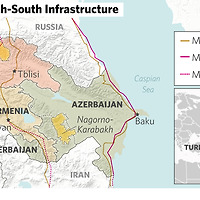그리스 피레우스항 사진, 출처: FP
Photo and English Sentences quoted, source: FP(Foreign Policy),
Why Is China Buying Up Europe’s Ports?
Foreign Policy(2018.02.02.)의 기사 내용을 발췌해 원문은 인용하고
한글 번역은 제가 직접했습니다.
중국이 유럽 전체 항만 능력의 1/10을 차지했다는 뉴스입니다.
이 뉴스를 보며 많은 생각이 들었지만
중국의 일대일로 "전략"이 생각보다 더 공세적이고
그로 인한 정치적 영향력이 더 커지겠다는 생각,
미국과 유럽권의 언론들은 "여전히" 일대일로가 육로와 해로에 국한되거나
또는 그 해로가 남중국해~인도양~유럽을 연결하는 구간이라 해석하고 있구나라는 생각.
중국의 일대일로는 모호한 컨셉으로 비추어질 수는 있으나
현재 육로에 메인 경제회랑을 건설하면서
기사와 같이 해로 연결을 위한 항만 터미널 인수에 착수 중.
다시 말해 중국은 일대일로를 통해 육로와 해로가 결국 만나는 구조로
뼈대를 구축하고 혈맥을 만들어갑니다.
저는 이를 중국 측에서 쓰고 있는 용어인
"차항출해(借港出海; 타국의 항만을 빌려 해양진출)"라는 개념과
필자가 직접 만든 신조어인 "차항입륙(借港入陸; 타국의 항을 통해 새로운 대륙 진입)"으로
현 상황을 분석한 바 있습니다.
재밌는 것은 FP에서는 이런 상황(중국의 유럽 항만 터미널 과잉 인수 상황)을
구한말 시기 열강들이 강제로 중국의 항만을 "개항"시켰던 것과 비교한 것입니다.
“For China, still shaking off what it views as a century of humiliation by Western countries — which culminated with the forced opening of Chinese ports by European gunboats — snapping up the sinews of modern commerce is a satisfying way to return to what it sees as the normal state of affairs.”
아무튼 가치 있는 정보와 분석 내용이라 일부 내용을 번역해 아래와 같이 게재.
이하, 번역물 및 원문_
중국의 1조 달러 규모의 대외정책 프로젝트인 “일대일로”는 공간 위에(현장에서) 성과 없는 모호한 개념이라 자주 풍자되고는 한다.
그러나 싱가포르에서 북해까지 북적거리는 항구들에서, 중국 국영기업들은 ‘물리적으로 글로벌 무역과 정치 영향력의 지도를 새로 그릴 수 있는 공격적인 인수’로 (일대일로의) 아이디어를 현실로 바꾸고 있다.
China’s trillion-dollar signature foreign-policy project, the Belt and Road Initiative, is often lampooned as just a fuzzy concept with little to show for it on the ground.
But in bustling ports from Singapore to the North Sea, state-owned Chinese firms are turning the idea into a reality with a series of aggressive acquisitions that are physically redrawing the map of global trade and political influence.
자금력 있는 한쌍의 중국 거대기업, Cosco Shipping Ports와 China Merchants Port Holdings는 인도양, 지중해, 그리고 대서양의 환(環)에서 화물 터미널을 최근 과잉 매입하고 있다. 바로 지난 달, 코스코는 벨기에에서 두 번째로 큰 지브루지(Zeebrugge) 내 터미널 인수를 마무리했다. 이 터미널은 중국 기업의 첫 북서부 유럽 내 교두보이다.
A pair of deep-pocketed Chinese behemoths, Cosco Shipping Ports and China Merchants Port Holdings, have gone on a buying binge of late, snapping up cargo terminals in the Indian Ocean, the Mediterranean Sea, and the Atlantic rim. Just last month, Cosco finalized the takeover of the terminal in Zeebrugge, Belgium’s second-biggest port, marking the Chinese firm’s first bridgehead in northwestern Europe.
이번 인수건은 스페인, 이탈리아, 그리스 등 최근 2년 내 성사된 다른 거래에 뒤따른 것이다. 한때 그들의 국내시장과 가까운 거리를 유지했던 중국 국영기업은 현재 유럽 전체의 항만 능력의 1/10을 컨트롤하고 있다.
That deal followed a raft of other acquisitions in Spain, Italy, and Greece in just the last couple of years. Chinese state firms, which once kept close to their home market, now control about one-tenth of all European port capacity.
항만 인수는 물리적으로 해운, 도로, 철로, 파이프라인을 통해 중국과 유럽을 연결하겠다는 베이징의 야심찬 계획(일대일로 말하는 듯)의 가장 분명한 증표(fuzzy concept의 반대어)이다.
The port deals are one of the clearest manifestations of Beijing’s ambitious plans to physically link China to Europe by sea, road, rail, and pipeline.
인수된 항만들은 남중국해에서 시작해 인도양을 지나, 수에즈 운하를 통과해 유럽의 가장 취약한 부분으로 진입하는, 일대일로의 절반에 해당하는 해양(일대일로 中 일로; 21세기 해상실크로드)을 지탱해준다.
The ports underpin the maritime half of the Belt and Road Initiative, snaking from the South China Sea across the Indian Ocean, through the Suez Canal and into the soft underbelly of Europe.
'일대일로의 모든 것 > 일대일로 신문 분석' 카테고리의 다른 글
| [일대일로의 모든 것] 캅카스, TRACECA, 남북경제회랑 자료 (0) | 2018.02.08 |
|---|---|
| [일대일로] 러시아~중국~베트남 화물열차 시범 운행 소식 (0) | 2018.02.04 |
| [일대일로] 영국총리 테레사 메이 방중 관련 보도 분석 (0) | 2018.02.03 |
| 남미, 그리고 일대일로 (0) | 2018.01.24 |
| 중국의 허브 전략, 일대일로 (0) | 2018.01.24 |





